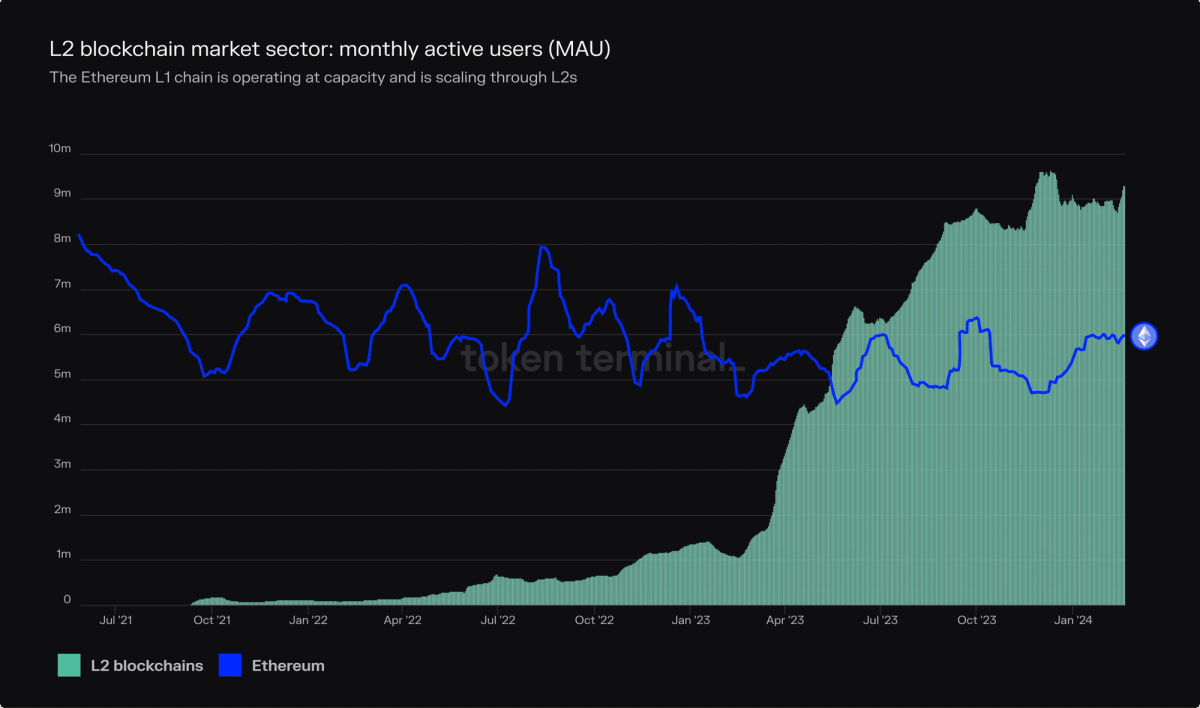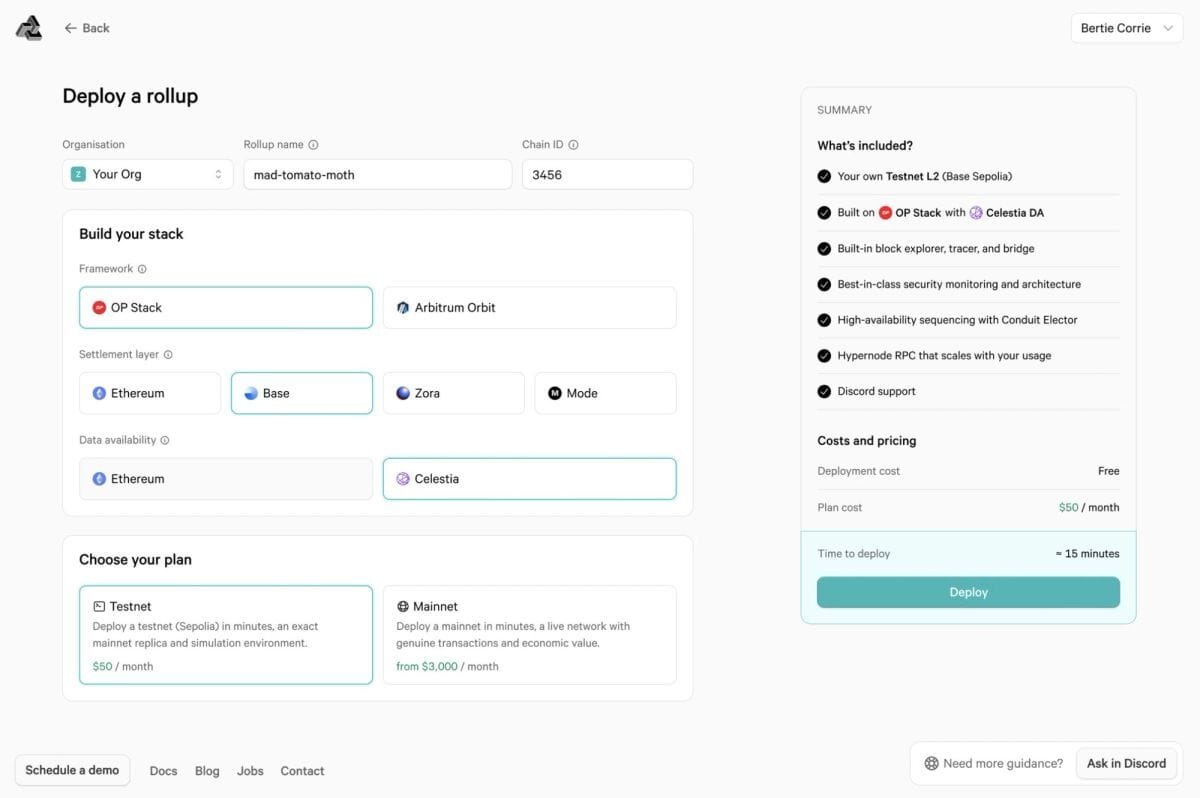- Token Terminal
- Posts
- Weekly fundamentals – From building blockchainsTM to building businesses
Weekly fundamentals – From building blockchainsTM to building businesses
Weekly fundamentals – From building blockchains™ to building businesses

Introduction
This week’s newsletter covers the rapidly growing Blockchains (L2) market sector. We zoom out and reflect on how the sector came to be, how it has evolved over the past four years, and highlight a few emerging trends that we’re seeing in the market.
Let’s jump in!
Outline
The Ethereum L1 has hit its capacity limit and needs to scale vertically.
L2 chains are easy to launch, offer cheaper fees, unlock new use cases, and thereby attract more users than the L1 chain.
As the infrastructure gets commoditized, the focus shifts to building sustainable onchain businesses.
The L2 stack gets (at least temporarily) unbundled as a result of Ethereum L1’s high fees.
General-purpose chains build “movements”, whereas application-specific chains build user-facing products.
The general-purpose L2 market is likely a “winner takes most” market, given the similarities in technical architectures between competing projects.
The Ethereum L1 has hit its capacity limit and needs to scale vertically.
It was clear from the very beginning that a single chain, here the Ethereum L1 chain, could never scale to a point where the global economy could run on it. As a result, Vitalik laid out an L2-centric scaling roadmap, which describes how Ethereum scales vertically through thousands of L2 chains that are all technically and/or brand-wise connected to the main L1 chain. This vision has gone from R&D to reality over the past four years, as Ethereum L2s today host close to ~10m MAUs vs. Ethereum L1’s ~6m MAUs.

Source: Ethereum project dashboard.
L2 chains are easy to launch, offer cheaper fees, unlock new use cases, and thereby attract more users than the L1 chain.
Many RaaS (Rollup as a Service) entrepreneurs saw the clear product-market-fit of L2s, but also the struggles that teams encountered when deploying their own chains. Today, we’re at a point where it’s as easy for teams to deploy their own L2 chain, as it is for them to deploy a smart contract on the Ethereum L1 chain. This ease of development has led to a plethora of new launches, many of which would not have been possible without access to more cost-efficient L2 blockspace.
As the infrastructure gets commoditized, the focus shifts to building sustainable onchain businesses.
Given how easy it is for application developers to deploy an L2 chain today, the market is finally starting to pay attention to entrepreneurs that build high-growth, sustainable onchain businesses instead of blockchains™. The most successful L2s think of themselves as startups, not novel data structures that solve the inherent scalability limitations of the L1. These projects seek (i) growth, and improved ways to (ii) monetize, and (iii) save on costs.

Source: Twitter.
The L2 stack gets (at least temporarily) unbundled as a result of Ethereum L1’s high fees.
The first wave of Ethereum L2s, like Optimism and Arbitrum, were really closely tied to (“aligned with”) the Ethereum L1. Turns out that this alignment is extremely expensive to maintain – both Optimism and Arbitrum pay millions of dollars (in ETH) per month to Ethereum for the right to settle their transactions on the main chain. Again, many entrepreneurs saw the “Ethereum L1’s fat margin as their opportunity”. Protocols like Celestia and EigenLayer aim to "unbundle the L2 stack", by providing services to L2s at ~100-1,000x cheaper prices than the Ethereum L1 can – this competition is also likely to speed up the Ethereum L1 core development.

Source: Arbitrum project dashboard.
General-purpose chains build “movements”, whereas application-specific chains build user-facing products.
From a business PoV, there are two types of L2 chains: general-purpose & application-specific. Similarly, from a technical PoV, there are 2 types of L2 chains: optimistic & ZK. Roughly speaking, general-purpose L2s intend to "build a new asset Hub for the Internet", whereas application-specific L2s aim to "build the best possible user experience for XYZ use case." In both cases, the L2 architecture is merely an "extension" of the core team's original vision for the product.

Source: Trending contracts (Arbitrum).
The general-purpose L2 market is likely a “winner takes most” market, given the similarities in technical architectures between competing projects.
As is the case for many other markets, the general-purpose L2 market sector tends to obey a power law, where a few successful L2s capture a majority of the mind and wallet share of users. The below screenshot highlights the current top contenders among general-purpose Ethereum L2s.

Source: Trending contracts (Ethereum).
🤝 The Token Terminal Data Partnership
An end-to-end onchain data analytics offering for L1s, L2s, and appchains. As part of the Data Partnership, we run nodes for your chain and make the chain’s data available in raw, decoded, and standardized formats across all of our platforms and data products.
Customer story – Matter Labs (zkSync)
Meet us at ETHDenver next week!
Meet us at @EthereumDenver next week! 👋📊
If you're interested to talk about onchain fundamentals & partnering with Token Terminal, feel free to DM us or @SebastianMotel1 directly to set up a time for a meeting!
— Token Terminal (@tokenterminal)
3:35 PM • Feb 21, 2024

